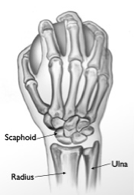The vital role that our hands play in daily life is often times only fully understood when we lose use of one or both as a result of an injury. The wrist joint is particularly vulnerable because of its range of motion and location – involved in lifting, twisting, hammering, blocking a blow and softening the impact of a fall. As a result, wrist fractures are among the most common fractures of the hand and upper extremity.

Some of the most common types of wrist fractures include:
Each of these fractures has their own unique challenge, which is why it is important that wrist fractures are treated by a hand and wrist specialist who understands the delicate bones of the hand and wrist, the blood supply to these bones and the intricate network of ligaments, tendons and nerves. The wrong treatment, or lack of treatment, could result in long term damage to the joint and decreased hand function.
Distal Radius Fractures

A distal radius fracture is one of the most common types of wrist fractures. It is named for the location of the break and bone it affects – the distal end of the larger forearm bone known as the radius. This type of fracture should be carefully examined to determine if the fracture extends into the wrist joint (intra articular fracture) or does not impact the wrist joint (extra articular fracture). The type of fracture will determine the type of treatment.
Scaphoid Fractures
A scaphoid fracture is a fracture of the scaphoid bone in the wrist, located at the thumb side. These types of fractures require special attention, as the blood supply for the scaphoid bone enters from the top and most fractures occur in the middle or bottom portion. This compromises the blood supply and can impede healing. Ensuring its stability is essential in preserving the integrity of the wrist joint and avoiding avascular necrosis.
The treatment for these types of wrist fractures will depend on the severity of the fracture and other soft tissue damage. Treatment will also be based on other aspects of a patients overall health and level of activity. Ensuring the proper alignment and healing of the fracture is important in avoiding future problems in the hand and wrist.
All treatment is followed by hand therapy and rehabilitation exercises to ensure that there is no loss in arm strength and function. The goal of Dr. Collins and his hand and upper extremity support staff is to return patients to their daily lives quickly and as strong as they were before the injury.

